Captured German Combat Map of 'Mirecourt 84C' France Sector
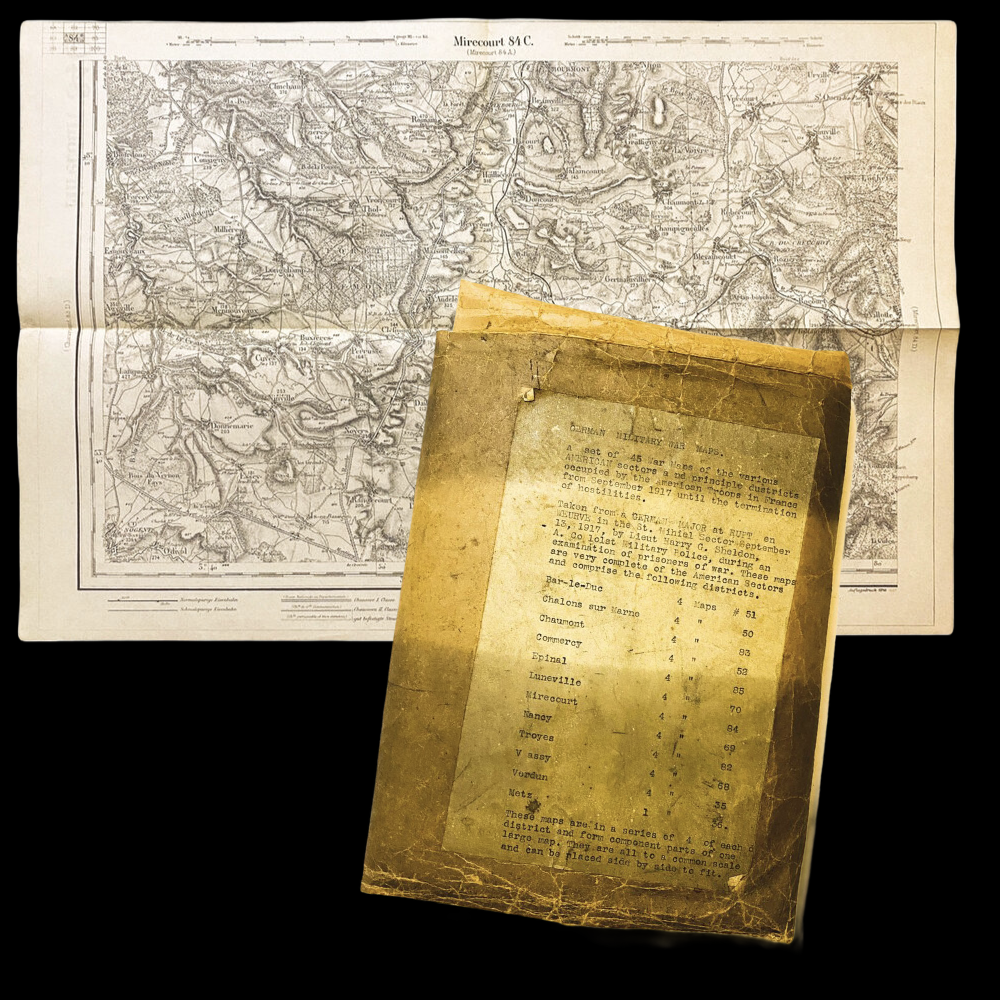
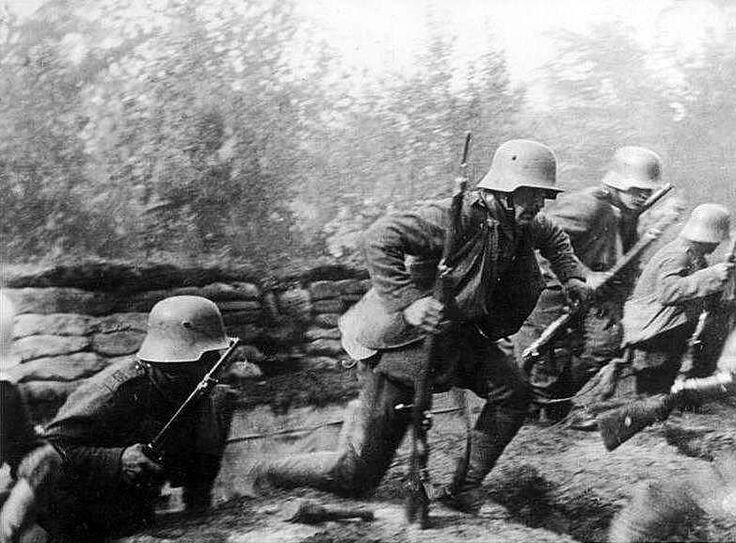
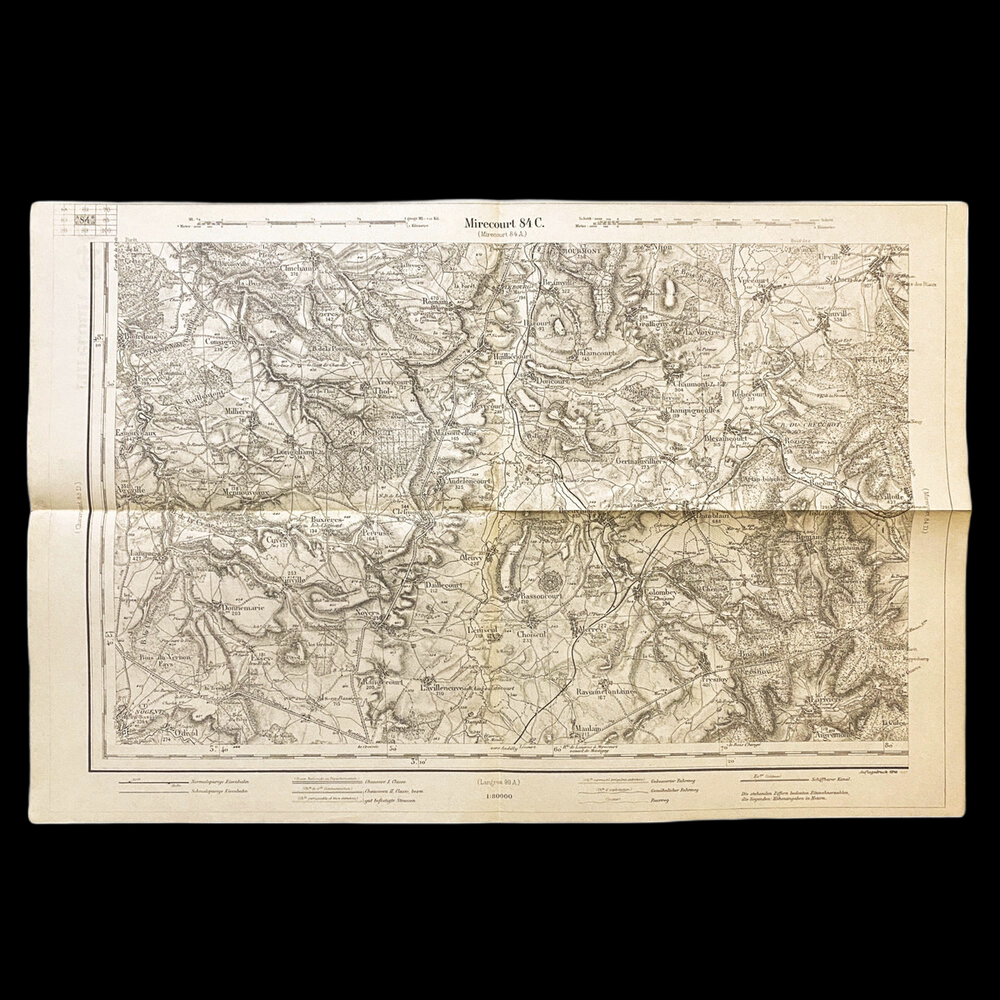

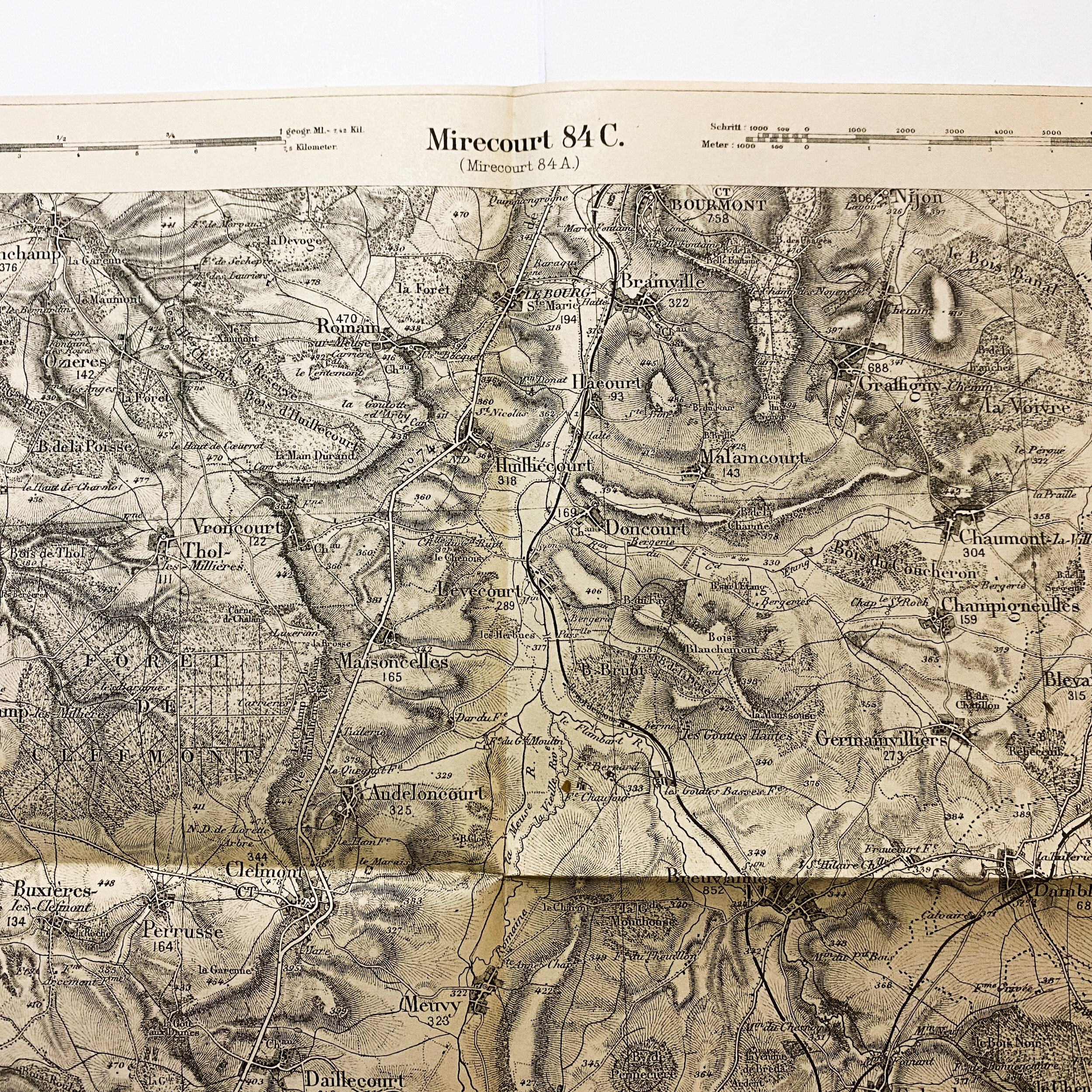




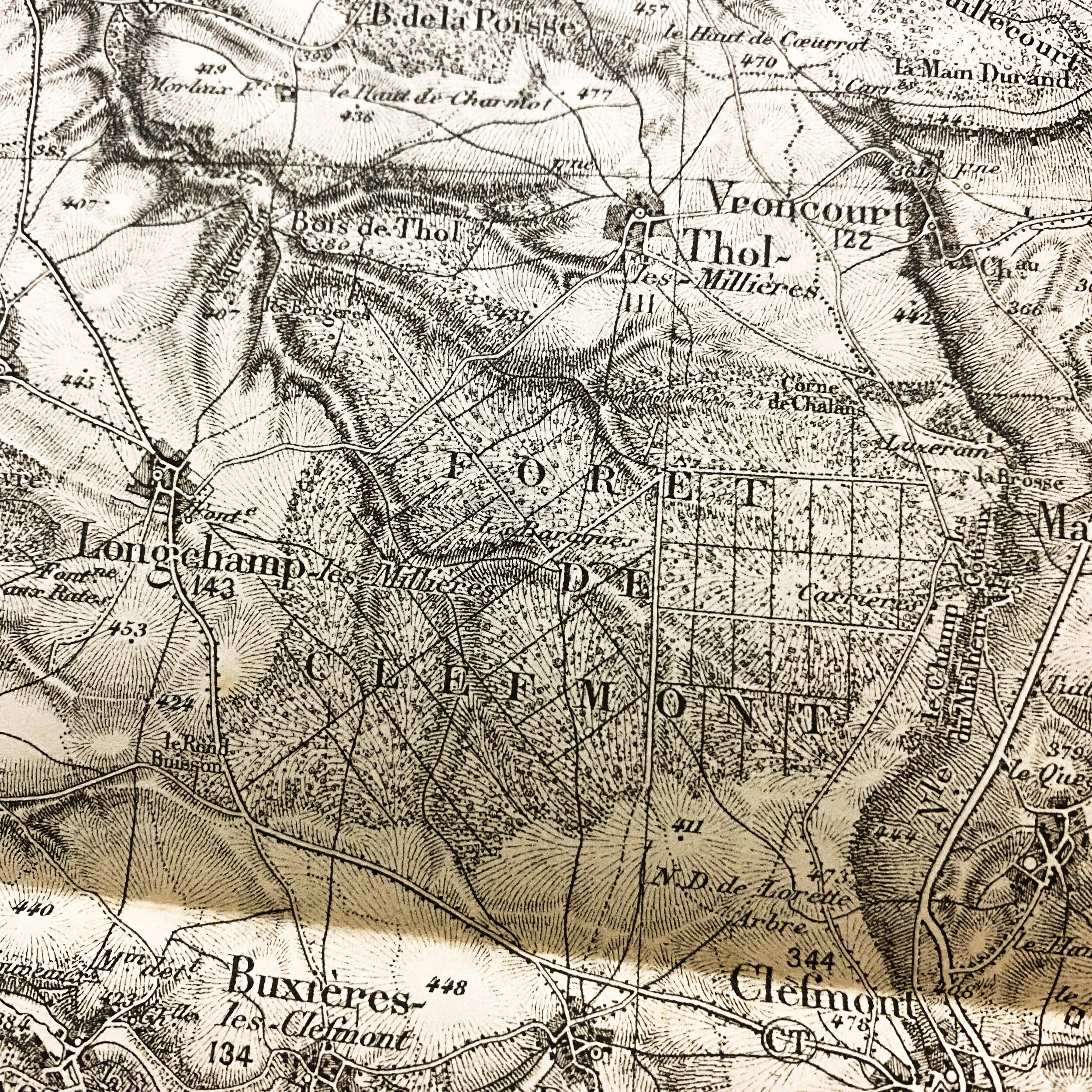




Captured German Combat Map of 'Mirecourt 84C' France Sector
Size: 18.5 x 12.5 inches
This original WWI German combat map of the ‘Mirecourt’ France sector. This map is one of 45 taken off of a German major on the battlefield of ‘Rupt en Weurve’ in the St. Mihiel Sector on September 13th, 1917 by Lieut. Harry G. Sheldon of the A.E.F. forces. These maps are broken into sets of 4 being label A,B,C and D of each given sector and district. Putting these section together forms a large map. They are all common scale and can be placed side by side to fit. This map is labeled ‘Mirecourt 84C’ and is 1 of 4 maps for this given sector.
This map would have utilized and used in the Mirecourt sector also located near the towns of Epinal and Nancy where the Battle of Grand Couronné took place. This map features notable locations such as the Rocourt, Bassoncourt, and Forest de Clefmont.
Battle of St. Mihiel:
The Battle of Saint-Mihiel was a major World War I battle fought from 12–15 September 1918, involving the American Expeditionary Forces (AEF) and 110,000 French troops under the command of General John J. Pershing of the United States against German positions. The U.S. Army Air Service played a significant role in this action.
This battle marked the first use of the terms "D-Day" and "H-Hour" by the Americans.
The attack at the Saint-Mihiel salient was part of a plan by Pershing in which he hoped that the Americans would break through the German lines and capture the fortified city of Metz. It was the first and only offensive launched mainly by the United States Army in World War I, and the attack caught the Germans in the process of retreating. This meant that their artillery was out of place and the American attack, coming up against disorganized German forces, proved more successful than expected. The Saint-Mihiel attack established the stature of the U.S. Army in the eyes of the French and British forces, and again demonstrated the critical role of artillery during World War I and the difficulty of supplying such massive armies while they were on the move. The U.S. attack faltered as artillery and food supplies were left behind on the muddy roads. The attack on Metz was not realized, as the Supreme Allied Commander Ferdinand Foch ordered the American troops to march towards Sedan and Mézières, which would lead to the Meuse-Argonne Offensive.
General John Pershing thought that a successful Allied attack in the region of St. Mihiel, Metz, and Verdun would have a significant effect on the German army. General Pershing was also aware that the area's terrain setting first dictated that the restricted rail and road communications into Verdun (restrictions that had been imposed by the German attack during the Battle of Flirey) be cleared, and that a continuation of the attack to capture the Germany railroad center at Metz would be devastating to the Germans. For this, he placed his confidence in a young First Infantry Division Major, George Marshall, to move troops and supplies effectively throughout the battle. After these goals were accomplished, the Americans could launch offensives into Germany proper. The American First Army had been activated in August and taken over the sector of the Allied line. Pershing had to persuade Marshall Foch (the supreme Allied military commander) to permit an American attack on the salient.
Battle of Grand Couronné:
The Battle of Grand Couronné took place in France after the Battle of the Frontiers, at the beginning of the First World War. After the German victories of Sarrebourg and Morhange; pursuit by the German 6th Army and the 7th Army took four days to regain contact with the French. The Germans attacked to break through French defenses on the Moselle, from 24 August – 13 September in three phases, the Battle of the Trouée de Charmes (24–28 August) when the German offensive was met by a French counter-offensive, a period of preparation from 28 August – 3 September, when part of the French eastern armies was moved westwards towards Paris, then a final German attack against the Grand Couronné de Nancy. The battle was fought day and night from 4–13 September 1914 by the 6th Army and the French Second Army
The German offensive began during the night of 3 September, against the fortifications of the Grand Couronné, either side of Nancy, which pushed back the 2nd Group of Reserve Divisions with the 59th, 68th and 70th Reserve divisions (General Léon Durand) to the north and the XX Corps (General Maurice Balfourier) to the south, by the evening of 4 September. In the afternoon of 5 September, Castelnau telegraphed to Joffre that he proposed to evacuate Nancy rather than hold ground, to preserve the fighting power of the army. Next day Joffre replied that the Second Army was to hold the area east of Nancy if at all possible and only then retire to a line from the Forest of Haye to Saffais, Belchamp and Borville. The civilian authorities in the city had begun preparations for an evacuation but the troops on the Grand Couronné repulsed German attacks on the right flank during 5 September; the Reserve divisions were only pushed back a short distance, on the front to the east and north of Nancy. An attempt by Moltke to withdraw troops from the 6th Army, to join a new 7th Army being formed for operations on the Oise failed, when Rupprecht and Dellmensingen objected and were backed by the Emperor, who was at the 6th Army headquarters. German attacks continued on 6 September and the XX Corps conducted a counter-attack, which gave the defenders a short period to recuperate but the troops of the 2nd Group of Reserve Divisions, east and north of Nancy began to give way.
Battle Order:
On 7 September, German attacks further north drove a salient into the French defenses south of Verdun at St. Mihiel, which threatened to separate the Second and Third armies. At Nancy, part of the 59th Reserve Division retreated from the height of St. Geneviève, which overlooked the Grand Couronné to the north-west of Nancy, exposing the left flank of the Second Army and Nancy to envelopment. Castelnau prepared to withdraw and abandon Nancy but was circumvented by the Second Army staff, who contacted Joffre and Castelnau was ordered to maintain the defense of the Grand Couronné for another 24 hours. (Castelnau had received news that one of his sons had been killed and gave the orders while shocked.) The French abandonment of the height of St Geneviève went unnoticed by the Germans, who had retired during the afternoon and the height was reoccupied before they could react. German attacks continued until the morning of 8 September, then diminished as Moltke began to withdraw troops to the right (west) flank of the German armies. Moltke sent Major Roeder from his staff to the 6th Army, with orders to end the offensive and prepare to retire to the frontier; only at this point did Rupprecht find out that the armies near Paris were under severe pressure. On 10 September, the 6th Army began to withdraw to the east. On 13 September, Pont-à-Mousson and Lunéville were reoccupied by the French unopposed and the French armies closed up to the Seille river, where the front stabilized until 1918.